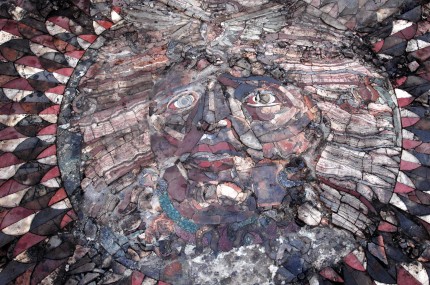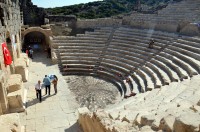 The only known surviving opus sectile mosaic of Medusa is finally being restored five years after its discovery in the ancient Odeon theater of Kibyra, in southwest Turkey’s Burdur Province. The 1,800-year-old masterpiece of the mosaic arts was unearthed during an archaeological excavation in 2009, but on the advice of Culture and Tourism Ministry experts was quickly covered with five layers of sand and gravel to preserve from the elements it until proper treatment could be arranged.
The only known surviving opus sectile mosaic of Medusa is finally being restored five years after its discovery in the ancient Odeon theater of Kibyra, in southwest Turkey’s Burdur Province. The 1,800-year-old masterpiece of the mosaic arts was unearthed during an archaeological excavation in 2009, but on the advice of Culture and Tourism Ministry experts was quickly covered with five layers of sand and gravel to preserve from the elements it until proper treatment could be arranged.
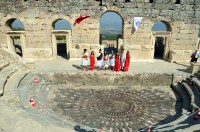 At 36 feet in diameter and 14 feet at the widest point, it’s the largest mosaic still in situ in Anatolia. It is almost entirely intact, with an estimate 95% of its thin marble tiles still in place. Authorities are keen to keep it in its original context so visitors can enjoy the rare pleasure of seeing it the same way the ancients did rather than removed from its orchestra pit semi-circle and placed in a museum. The Kibyra Odeon could seat 3,600 people and was used for musical and theatrical events as well as serving as legal court and legislative chamber during the cold months when its roof made it the most comfortable structure in town suitable for public use.
At 36 feet in diameter and 14 feet at the widest point, it’s the largest mosaic still in situ in Anatolia. It is almost entirely intact, with an estimate 95% of its thin marble tiles still in place. Authorities are keen to keep it in its original context so visitors can enjoy the rare pleasure of seeing it the same way the ancients did rather than removed from its orchestra pit semi-circle and placed in a museum. The Kibyra Odeon could seat 3,600 people and was used for musical and theatrical events as well as serving as legal court and legislative chamber during the cold months when its roof made it the most comfortable structure in town suitable for public use.
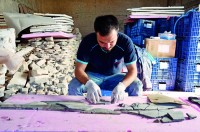 Last year the Medusa mosaic was uncovered for the first time since its discovery to allow conservators to perform a detailed feasibility study. This year, the Culture and Tourism Ministry funded the restoration based on the recommendations in last year’s report. Regional archaeologists are working with an Istanbul conservation company to restore the mosaic. They’ve been working on it for two months and expect to continue for another month.
Last year the Medusa mosaic was uncovered for the first time since its discovery to allow conservators to perform a detailed feasibility study. This year, the Culture and Tourism Ministry funded the restoration based on the recommendations in last year’s report. Regional archaeologists are working with an Istanbul conservation company to restore the mosaic. They’ve been working on it for two months and expect to continue for another month.
According to Düzgün Tarkan from the archaeology department of Mehmet Akif Ersoy University in Burdur, the mosaic has survived some very hard times.
He said they believed that the mosaic had suffered from a large fire in the ancient era. “In its original, it was covered with a wooden roof. This is why we believe that the timbers that fell during the fire burned the mosaic for days. The marble pieces that form the mosaic received great damage. Now we are merging them and the broken pieces are being attached to the mosaic.”
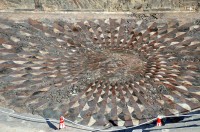 You can see in the images from last year’s study that there are areas where the opus sectile marble veneers are in fragments. That’s apparently the result of this devastating days-long fire that took down the wooden roof that once covered the Odeon. Some of the marble plaques that characterize the opus sectile style (as opposed to the small, regular squares of the opus tessellatum style) are just a single millimeter thick. It defies belief that all those shards remained in place so archaeologists could painstakingly piece them back together and reinstall them on site. Clearly Medusa’s petrifying visage really did protect her.
You can see in the images from last year’s study that there are areas where the opus sectile marble veneers are in fragments. That’s apparently the result of this devastating days-long fire that took down the wooden roof that once covered the Odeon. Some of the marble plaques that characterize the opus sectile style (as opposed to the small, regular squares of the opus tessellatum style) are just a single millimeter thick. It defies belief that all those shards remained in place so archaeologists could painstakingly piece them back together and reinstall them on site. Clearly Medusa’s petrifying visage really did protect her.
Once the mosaic is stabilized, it will be covered with a layer of glass (or a transparent material of some kind) to protect it from grubby tourist feet and hands, bad weather and all manner of other potential damage sources. That way visitors to the Odeon will be able to walk on Medusa’s face without hurting her.
